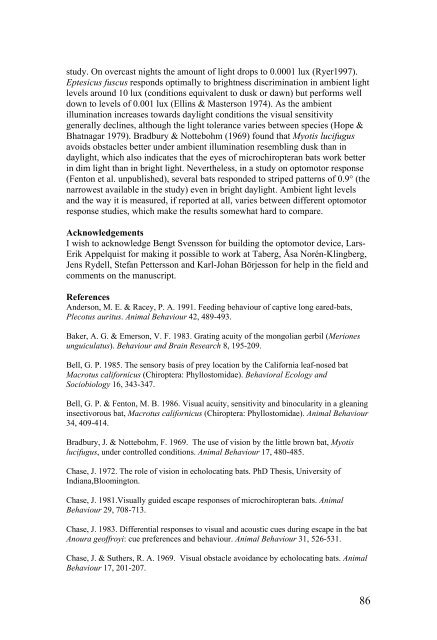Vision in echolocating bats - Fladdermus.net
Vision in echolocating bats - Fladdermus.net
Vision in echolocating bats - Fladdermus.net
Create successful ePaper yourself
Turn your PDF publications into a flip-book with our unique Google optimized e-Paper software.
study. On overcast nights the amount of light drops to 0.0001 lux (Ryer1997).<br />
Eptesicus fuscus responds optimally to brightness discrim<strong>in</strong>ation <strong>in</strong> ambient light<br />
levels around 10 lux (conditions equivalent to dusk or dawn) but performs well<br />
down to levels of 0.001 lux (Ell<strong>in</strong>s & Masterson 1974). As the ambient<br />
illum<strong>in</strong>ation <strong>in</strong>creases towards daylight conditions the visual sensitivity<br />
generally decl<strong>in</strong>es, although the light tolerance varies between species (Hope &<br />
Bhatnagar 1979). Bradbury & Nottebohm (1969) found that Myotis lucifugus<br />
avoids obstacles better under ambient illum<strong>in</strong>ation resembl<strong>in</strong>g dusk than <strong>in</strong><br />
daylight, which also <strong>in</strong>dicates that the eyes of microchiropteran <strong>bats</strong> work better<br />
<strong>in</strong> dim light than <strong>in</strong> bright light. Nevertheless, <strong>in</strong> a study on optomotor response<br />
(Fenton et al. unpublished), several <strong>bats</strong> responded to striped patterns of 0.9° (the<br />
narrowest available <strong>in</strong> the study) even <strong>in</strong> bright daylight. Ambient light levels<br />
and the way it is measured, if reported at all, varies between different optomotor<br />
response studies, which make the results somewhat hard to compare.<br />
Acknowledgements<br />
I wish to acknowledge Bengt Svensson for build<strong>in</strong>g the optomotor device, Lars-<br />
Erik Appelquist for mak<strong>in</strong>g it possible to work at Taberg, Åsa Norén-Kl<strong>in</strong>gberg,<br />
Jens Rydell, Stefan Pettersson and Karl-Johan Börjesson for help <strong>in</strong> the field and<br />
comments on the manuscript.<br />
References<br />
Anderson, M. E. & Racey, P. A. 1991. Feed<strong>in</strong>g behaviour of captive long eared-<strong>bats</strong>,<br />
Plecotus auritus. Animal Behaviour 42, 489-493.<br />
Baker, A. G. & Emerson, V. F. 1983. Grat<strong>in</strong>g acuity of the mongolian gerbil (Meriones<br />
unguiculatus). Behaviour and Bra<strong>in</strong> Research 8, 195-209.<br />
Bell, G. P. 1985. The sensory basis of prey location by the California leaf-nosed bat<br />
Macrotus californicus (Chiroptera: Phyllostomidae). Behavioral Ecology and<br />
Sociobiology 16, 343-347.<br />
Bell, G. P. & Fenton, M. B. 1986. Visual acuity, sensitivity and b<strong>in</strong>ocularity <strong>in</strong> a glean<strong>in</strong>g<br />
<strong>in</strong>sectivorous bat, Macrotus californicus (Chiroptera: Phyllostomidae). Animal Behaviour<br />
34, 409-414.<br />
Bradbury, J. & Nottebohm, F. 1969. The use of vision by the little brown bat, Myotis<br />
lucifugus, under controlled conditions. Animal Behaviour 17, 480-485.<br />
Chase, J. 1972. The role of vision <strong>in</strong> echolocat<strong>in</strong>g <strong>bats</strong>. PhD Thesis, University of<br />
Indiana,Bloom<strong>in</strong>gton.<br />
Chase, J. 1981.Visually guided escape responses of microchiropteran <strong>bats</strong>. Animal<br />
Behaviour 29, 708-713.<br />
Chase, J. 1983. Differential responses to visual and acoustic cues dur<strong>in</strong>g escape <strong>in</strong> the bat<br />
Anoura geoffroyi: cue preferences and behaviour. Animal Behaviour 31, 526-531.<br />
Chase, J. & Suthers, R. A. 1969. Visual obstacle avoidance by echolocat<strong>in</strong>g <strong>bats</strong>. Animal<br />
Behaviour 17, 201-207.<br />
86


